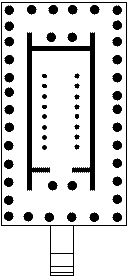It was a Doric peripteral temple, the largest in the Peloponnese. It had six columns on the short sides (hexastyle pteron) and thirteen on the long sides. Each column had 10.53m height and 2.25m minimum diameter. Although these were the heaviest columns in Greece, they were designed with harmony and symmetry.
The entablature was 4.09m in height and symmetrically proportioned. It was divided in architraves with broad surface, triglyphs, metopes and a cornice.
The east and west pediments depicted fine compositions made of Parian marble. Stylistically, the compositions belong to the Severe style. In both pediments, the sculptor placed the statues along the axis of the pediments.
The metopes of the pronaos and the opisthonaos depict the Labours of Herakles.
The most outstanding piece of art of the temple of Zeus was the chryselephantine statue of Zeus, stood in the main room of the temple (cella).
